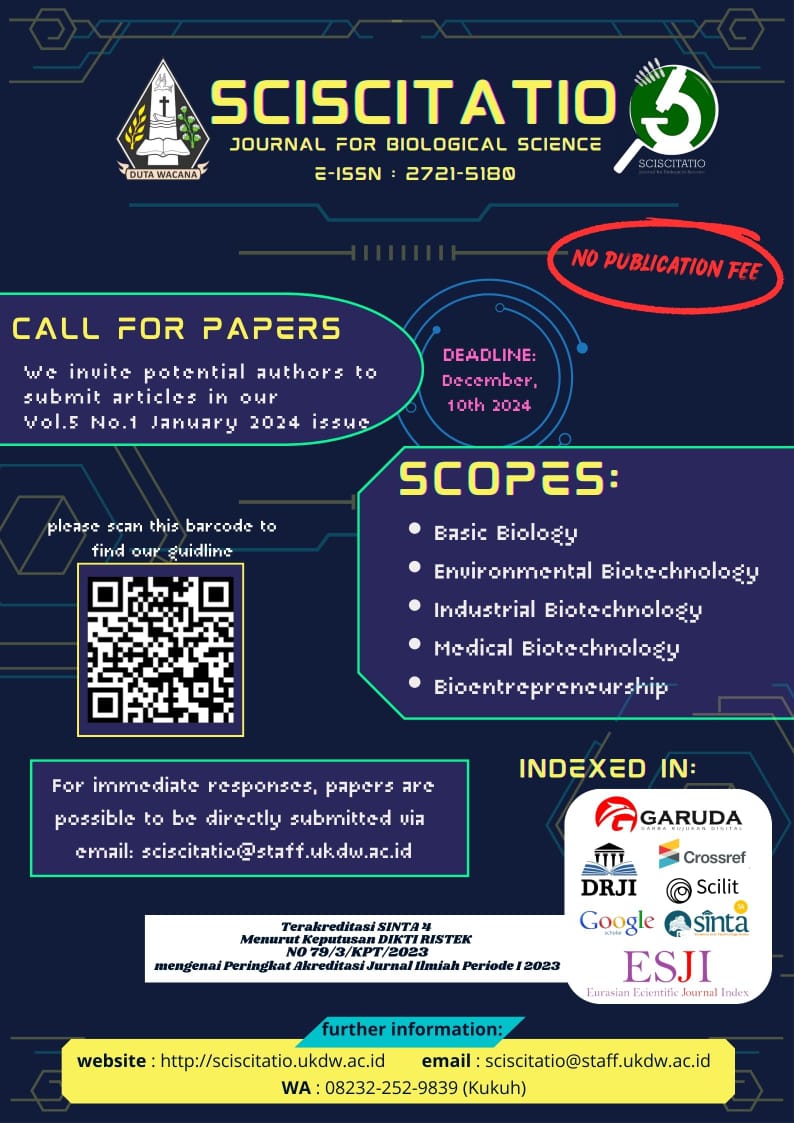Comparative Analysis of Mitragynine Content in Kratom Leaves (Mitragyna speciosa Korth) from Kabupaten Kapuas Hulu Using HPLC Method
DOI:
https://doi.org/10.21460/sciscitatio.2024.52.183Keywords:
chromatography, extraction, kratom, mitragynine, opioidAbstract
Opioid drugs are common analgesics for managing chronic pain, but they have significant short- and long-term side effects. Despite this, opioid consumption continues to rise in high-income countries, raising concerns about dependency. Kratom (Mitragyna speciosa Korth), which has opioid-like effects, shows potential as an analgesic with fewer side effects. This study aimed to explore and compare the mitragynine content in Kratom leaves from various regions in Kabupaten Kapuas Hulu, Indonesia, using High-Performance Liquid Chromatography (HPLC). Kratom leaves from 14 regions in Kapuas Hulu were collected, dried, and ground. Mitragynine was extracted using 70% ethanol and analyzed with HPLC. The yield percentage and mitragynine content in both the powdered simplisia and ethanol extract were measured and compared. The study showed that the average ethanol extract yield was 28%, with the highest yield from Elis Menendang (31.20%) and the lowest from Nanga Lauk (23.86%). Mitragynine content was significantly higher in the ethanol extract (3.22%) compared to the powdered simplisia (1.46%). Samples from Lanjak, Jongkong, Bunut, and Putussibau Kota showed mitragynine content exceeding 4% in the ethanol extract. HPLC analysis indicated that ethanol extraction significantly increases the mitragynine content in Kratom leaves compared to powdered simplisia, up to twice as much.
References
Ahmad, I. et al. (2022). Mitragyna Species as Pharmacological Agents: From Abuse to Promising Pharmaceutical Products. Life (Basel,bSwitzerland), 12(2):193.
Carpenter, J.M. et al. (2016). Comparative effects of Mitragyna speciosa extract, mitragynine, and opioid agonists on thermal nociception in rats. Fitoterapia, 109:87–90.
Chakraborty, S., Uprety, R., Daibani, A.E., et al. (2021. Kratom Alkaloids as Probes for Opioid Receptor Function: Pharmacological Characterization of Minor Indole and Oxindole Alkaloids from Kratom. ACS chemical neuroscience, 12(14):2661–2678.
Chakraborty, S., Uprety, R., Slocum, S.T., et al. (2021). Oxidative Metabolism as a Modulator of Kratom’s Biological Actions. Journal of medicinal chemistry, 64(22):16553–16572.
Eastlack, S.C., Cornett, E.M. and Kaye, A.D. (2020). Kratom-Pharmacology, Clinical Implications, and Outlook: A Comprehensive Review. Pain and therapy, 9(1): 55–69.
Farahani, Z.K. (2021). The effect of extraction method (ultrasonic, maceration and soxhlet) and solvent type on the extraction rate of phenolic compounds and extraction efficiency of Arctium lappa L. roots and Polygonum aviculare L. grass. Journal Food and Health, 4(2):28- 34.
Firmansyah, A., Sundalian, M. and Taufiq, M. (2021). Kratom (Mitragyna speciosa Korth) for a New Medicinal: a Review of Pharmacological and Compound Analysis. Biointerface Research in Applied Chemistry, 11: 9704–9718.
Foss, J.D. et al. (2020). Mitragynine, bioactive alkaloid of kratom, reduces chemotherapy-induced neuropathic pain in rats through a-adrenoceptor mechanism. Drug and alcohol dependence, 209:107946.
Hong, S. et al. (2023). BuprenorphineNaloxone in the Setting of Kratom Withdrawal Opionid Use Disorder, and Stage IV Lung Adenocarcinoma. Journal of Palliative Medicine, 26(5):734-736.
Janthongkaw, A. et al. (2023). Effect of Green and Red Thai Kratom (Mitragyna speciosa) on pancreatic digestive enzymes (alpha-glucosidase and lipase) and acetyl-carboxylase 1 activity: A possible therapeutic target for obesity prevention. PloS one, 18(9).
Jayawardana, S. et al. (2021). Global consumption of prescription opioid analgesics between 2009-2019: a country-level observational study. E-Clinical Medicine, 42:101198.
Leksungnoen, N. et al. (2022). Variations in mitragynine content in the naturally growing Kratom (Mitragyna speciosa) population of Thailand. Frontiers in plant science, 13:1028547.
Listos, J. et al. (2019). The Mechanisms Involved in Morphine Addiction: An Overview. International journal of molecular sciences, 20(17).
Mu amar, I. (2021). Eksplorasi potensi tumbuhan berkhasiat obat diabetes mellitus pada suku dayak bakumpai barito selatan kalimantan tengah. Journal of Health Science and Technology. 2(1):18-30.
Mustafa, R. et al. (2020). Enhancing Extraction Yield And Purity Of Mitragynine From Mitragyna Speciosa Through Sequential Solvent Extraction And Characterisation Using Nmr Technique. International Journal of Scientific & Technology Research, 9:3846–3854.
Ng, K. and Ha, T. (2024). Extraction and detection of mitragynine in Kratom leaves by high-performance liquid chromatography. Natural product research, 1–6.
Ningrum, A. M. et al. (2021). Probability induction of kratom plant bioactive components in antidiabetic and antiobesity studies. Bioeduscience, 5(3): 234–240.
Paankhao, N. et al. (2024). Antioxidant and antibacterial efficiency of the ethanolic leaf extract of Kratom (Mitragyna speciosa (Korth.) Havil) and its effects on growth, health, and disease resistance against Edwardsiella tarda infection in Nile tilapia (Oreochromis niloticus). Fish & shellfish immunology, 152(2024):109771.
Raini, M. (2017). Kratom (Mitragyna speciosa Korth): Manfaat, Efek Samping dan Legalitas. Media Penelitian dan Pengembangan Kesehatan, 27.
Sanagia, M.M. et al. (2013). Determination of mitragynine for the identification of mitragyna species in kedah (malaysia) by gas chromatographymass spectrometry. Scholars Research Library, 5(5):131-138.
Saref, A. et al. (2019). Self-reported prevalence and severity of opioid and kratom (Mitragyna speciosa korth.) side effects. Journal of ethnopharmacology, 238: 111876.
Sim, Y.S. et al. (2022). Development and validation of a gradient HPLC-UV method for mitragynine following in vitro skin permeation studies. Journal of chromatography. B, Analytical technologies in the biomedical and life sciences, 1204,
Singh, D. et al. (2018). Severity of Pain and Sleep Problems during Kratom (Mitragyna speciosa Korth.) Cessation among Regular Kratom Users. Journal of psychoactive drugs, 50(3): 266–274.
Suhaimi, S. et al. (2019). Uji Daya Hambat Ekstrak Kental Daun Kratom (Mitragyna speciosa Korth) Terhadap Bakteri Propionibacterium acnes Sebagai Penyebab Jerawat. Medical Sains: Jurnal Ilmiah Kefarmasian, 4(1):1–6.
Sureram, S. et al. (2024). Discovery of procyanidin condensed tannins of epicatechin from Kratom, Mitragyna speciosa, as virucidal agents against SARS-CoV-2. International journal of biological macromolecules, 273(1):133059.
Toklo, P.M. et al. (2023). UPLC-QToF-ESI-MS identification and anthelmintic activity of Mitragyna inermis (Willd.) Kuntze (Rubiaceae). Heliyon, 9(6): e16448
Varadi, A. et al. (2016). Mitragynine/Corynantheidine Pseudoindoxyls As Opioid Analgesics with Mu Agonism and Delta Antagonism, Which Do Not Recruit B-Arrestin-2. Journal of medicinal chemistry, 59(18): 8381–8397.
Zhang, L. et al. (2020). Mu Opioid Receptor Heterodimers Emerge as Novel Therapeutic Targets: Recent Progress and Future Perspective. Frontiers in pharmacology, 11:1078.
Downloads
Published
How to Cite
Issue
Section
License
Copyright (c) 2024 THE AUTHOR(S)

This work is licensed under a Creative Commons Attribution-ShareAlike 4.0 International License.

